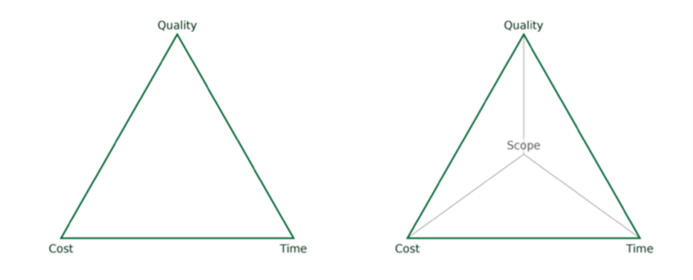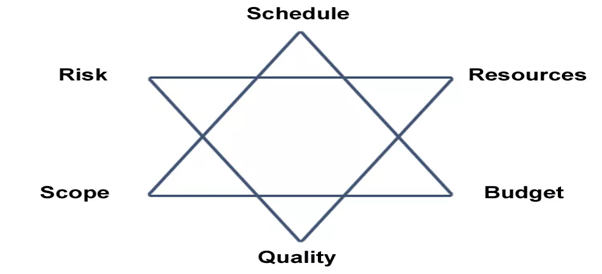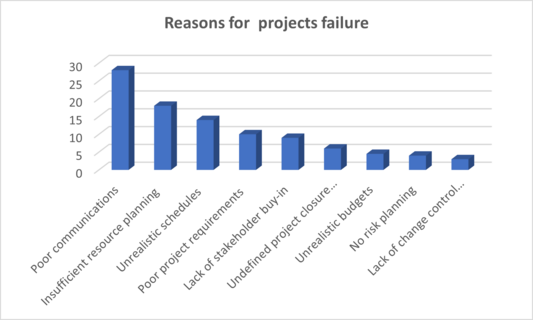The magic triangle as a project management tool in cost estimation and budgeting
Contents |
ABSTRACT
The definition of project success to many has been limited to only three main measurement criteria popularly known as ‘The iron/magic triangle’ (Atkinson, 1999). According to Freeman & Beale,1992 - these are the three key pillars of the triangle and includes ‘Cost’ –measured in terms of meeting the budget, ‘Time’ – measured in terms of meeting the schedule, and ‘Quality and Scope’ – measured in terms of meeting the requirements and scope, adhering to functional and technical specifications, defects, and reliability at the commencement of the execution phase. This article focuses on the magic triangle as a project management tool for delivering the scope of a project taking into account cost estimation and budgeting and some limitations of this triangle in project management. Some modifications by PMBOK has also been given in this article. Based on statistics, project managers tend to focus on cost and time for project delivery as they are the main criteria by which they are assessed. Many consider a project as success when it is delivered under budget, time and all the requirements and quality of the project are met. These three pillars even though are very important but have some limitations because the success of a project cannot be limited to only cost, time and quality. Project managers may need some other important tools like key performance indicators that serve as a guide in the execution of projects. This article also delves into a few type of cost estimation methods used for budgeting projects, the applications as well as the limitations of the magic triangle as a project management tool. The terms magic triangle, iron triangle and the triple of constraints are used interchangeable in this article to mean the same.
Contents
• Abstract
• Contents
• The big idea and concept of the magic triangle as a tool in project management.
• Cost
• Time
• Quality
• Applications of the magic triangle
• Limitations of the magic triangle in project management.
key words: cost estimation, project success, iron/magic triangle, project management ,key performance indicators.
References:
https://theconstructor.org/construction/methods-cost-estimation
https://www.villanovau.com/resources/project-management/iron-triangle-project-management/
The Big Idea and Concept of the Iron triangle
The iron triangle is a very important model used to define the purpose of a project based on three key important pillars also known as the triple of constraints in project management. The three constraints are cost, time and quality and depending on the project manager, a fourth one called the scope may be included. The scope is usually located in the middle of the triangle because it is the scope that determines the three constraints such as cost, quality and time.
The position of these three pillars depends on the original scope of the project , the purpose of the project or its desired outcome depending on the amount of resources and time available. However, it normally requires an experienced project manager to balance or adjust these three pillars to achieve the desired outcome. The iron triangle also forms the basis of the success criteria that will later be used to ascertain whether a project is a success or failure. The success criteria however goes beyond the three pillars to include other factors like safety and scope. Each of the three constraints are discussed below in a much greater detail.
Cost
The cost of a project includes the estimated budget and resources both capital and human available for the execution of the entire project. Cost is a very important factor in budgeting to achieve the desired outcome of a project delivery. The cost must be reasonably estimated because it can affect other factors such as schedule, project delivery and quality as the three constraints are interdependent. The cost of defined scope of a project can be redefined depending on the scope of the project and that can affect the project quality and the project delivery time. For instance, decreasing cost will likely decrease project quality and increasing cost will likely increase the quality. This is because the cost directly affects the resources available both human and capital for the execution of the project. In determining the cost of a project, its important for the project manager to consider effectively plan by considering other factors like inflation and uncertainties like unknown unknowns that can significantly delay projects and affect their critical path and delivery dates. Project managers always try to opt for the lowest cost possible however it requires experience to balance or adjust them in order not to affect the quality of the desired outcome. Cost estimation forms the basis for budgeting and is also known as the financial constraint of the iron triangle. For instance, when the cost is increased it means more workers can be employed to speed up project delivery and capital or resources can also be increased simultaneously. Cost estimation and budgeting are very important especially in the initial phase of the project planning.
Time
A project delivery time involves planning and scheduling and using the critical path to predict the shortest project delivery time. It is always advisable for project managers to have three options in planning and scheduling. The impossible project delivery time should be given to the stakeholder, the likely one be given to project teams and the most likely for the project manager himself. Project managers always tend to consider the shortest realistically possible project delivery time, however cost and uncertainties should be taken into account when planning the project delivery time without affecting the quality.
Quality
Quality is the product of time and cost because these two constraints determine whether a project is a success or failure. The quality therefore determines whether the desired outcome and scope of the project are achieved or not. The quality of a project extends to the requirements of the project as initially defined by the scope of the project. Quality delivery can be assessed as soon as the project is completed, the success however may be realized immediately or perhaps take many years to be able to evaluate its success or failure after the project has ended All the triple constraints of the iron triangle are governed by the scope of the project which is usually found in the middle of the triangle. The scope of a project comprises all the necessary tasks that need to be carried out to achieve the project’s overall goal. Any change affecting time and cost eventually affects the scope of the project and requires experience and expertise of project managers to find the right balance between the three constraints of the iron triangle. Depending on some factors, the scope of a project can be redefined by the stakeholders, or the project manager and some adjustments can also be made to achieve the desired quality and outcome. There two types of scope definition or goal setting in project management depending on the setting, namely SMART and FAST goal setting. The SMART goal method is more frequently used however, due to complexity nature of projects and the long-term outcome, the FAST goal setting method is gaining popularity nowadays.
Applications of the iron triangle
I believe the iron triangle in project management forms the foundation of project’s lifecycle from planning to development and completion. The scope of a project cannot be defined without using the iron triangle because it’s very crucial in the initial stages of a project. There are always other factors to consider beyond the iron triangle. The three key pillars of the iron triangle located around the vertices of the triangle are.
• Time
• Quality
• Cost
Time - A very important pillar of the iron triangle because it provides information for scheduling and prioritizing tasks to deliver the project within time and under budget. Prioritizing the most important tasks, proper scheduling, and the use of work breakdown structures like Gannt diagram and Scrum plan methods to mention but just a few in planning will provide information about the project and whether it is on tract of the project delivery time. Additionally, the use of stakeholder matrix, task identification and scheduling are some of the tools that can be used when it comes to time management in the iron triangle. When these tools are effectively utilized, it will ensure that the project delivery is on tract. Generally, project managers always opt for the shortest project delivery time known as the critical path, however it is recommended to consider the following scenarios in the critical path analysis. The three scenarios are Most likely, Optimistic and Pessimistic abbreviated as MOP. The most likely which is based on the most realistic cost or project delivery should be kept by the project manager himself for reference. The Optimistic method is based on the best scenario of a project activity and this plan should be given to the project team or members. The last method called pessimistic which is based on the worst-case scenario of the project activity should be given to the stakeholders. While this is done, the project manager can opt for the most likely scenario which is usually called the critical path is defined as the shortest predicted project delivery time. The quality of a project is about whether the project meets the requirements of the scope earlier defined by the project manager. Several factors affect the quality of a project mainly cost and time. In a case where the requirements and quality of the project are not met, it can be deemed to be a failure. On the other hand, when all the requirements are met, and the desired outcome achieved then it is considered a success. The success of some projects can easily be determined while others that are very complex may take a longer time to get the benefits and the desired outcome. A similar scenario is the Sydney Opera House in Australia that took so many years to realize its quality and benefits. The quality of a project can be assessed using quality assurance by contracting third parties or the project manager who supervised the project. All these three key pillars of the magic triangle when balanced and effectively used by the project manager will ensure that projects become a success.
Cost - The scope usually found in the middle of these three core pillars. According to ISO 21502, the purpose of cost estimation is to establish the financial controls to be used throughout the lifecycle of the project to facilitate delivery within the approved budget. For instance, the cost estimation of a project include the cost of materials and resources (including human resources) that will be available for the execution of the project. Thus, cost estimation as a key pillar of the iron triangle provides more information for planning, scheduling, and budgeting. The principle of cost estimation involves estimating each component of the planned work to be done, developing a budget, and using control techniques such as earned value management to monitor and foretell future performance of the company. Budgeting and cost estimation go hand in hand, however budgeting is broader and involves using cost estimation to provide a general overview of the allocated funds available in order to spend within the budget, avoid or reduce overspending and embezzlement of funds. Making estimation of costs can be a headache even to many experienced project managers. I have therefore delved into a few of the most popular cost estimation methods used by project managers below. The estimation of cost is done using one or more or a combination of the following methods. It is also noteworthy that, there are two main methods of estimation. Ground up and Top down estimation methods.
• Analogous estimation - In this type of estimation costs, the project manager uses similar projects that were completed by the same organization to estimate the current project and by using historical data of important projects of the same profile. The analogous method can be used to estimate cost of equipment, Project overheads, travel expenses and other costs that might be incurred by contracting third party contractors to do certain works.
• Expert Judgement - This method is very quick, easy and requires no resources to be carried out. However, it requires experience in similar projects and the ability to foresee things. There are other estimation methods like data analysis, decision making ect.
• Parametric estimation - Project management is the second most important competence of an engineer. This is where the project manager uses parameters of project data or historical data of past projects and breaks them down into smaller units for easy estimation. For instance, if we need about 100 bags of cement for a project, then what’s the cost of each bag of cement? This way, the project manager can easily estimate the cost of the entire project. This method also involves the use of modern software like Agile to facilitate operations and compare statistical data.
Limitations of the iron triangle
The magic triangle despite its importance in project management has some limitations that need to be addressed.The iron triangle should be modified because of the following limitations.
• Wrong measurements (particularly baseline). First of all, the perception that the triple of constraints ensure on time delivery ,on budget and project quality is not entirely true and the actual scope of the project cannot be limited to only these as it tends to affect project success in general. The concept of this iron triangle is too traditional and simplistic because the scope of complex projects evolve with time and circumstances.
• The iron triangle is incomplete because other important factors like safety, benefits, etc are ignored. The magic triangle is only used as a tool for the execution of a project but cannot be used to ascertain the success of a project. The triangle should be modified to include other tools that are used by management.
• The iron triangle undermines the overall Investment and focus of projects:
Projects exist not to be delivered on time, cost and quality but to add value to the society. Thus it undermines the investment goals and focus of projects. Projects are designed to serve a particular purpose and so when the cost and project delivery time is manipulated, it affects the actual purpose of the project. Attempts by project teams to target project delivery at the expense of the desired outcome and long-term benefits affect the detailed plan and scope of the project leading to some portions of the benefits being left out. What project managers and stakeholders should rather consider is that, the project should be able to achieve the goal for which it was planned and whether the project was completed on budget or on time should be a secondary matter.
• Cost and time estimations are uncertain and unrealistic.
Cost estimations are done when uncertainty is at its highest. Projects are full of uncertainties when estimating costs, time and the quality or scope cannot be defined in detail. The need for flexibility is what the magic triangle is lacking. For instance, If the initial investment target was 80%, a reduction in quality is likely to occur because of tight unrealistic budget and time will reduce it to about 60 %. However, cost needs to be optimized to avoid over expenditure and inflation of budgets which do not match with the benefits and outcome of projects.
Why the magic triangle needs to be modified ?
The magic triangle needs to be modified and some other important management tools needs to be incorporated into it to make it more reasonable. An alternative to the triple of constraints known as the project management star has been proposed by the PMBOK® Guide which has six constraints instead of three. This looks much better than traditional magic triangle because of the addition of risk but still looks incomplete. However, this seems to be the future of the magic triangle and can adopted by project managers. Below is a diagram of the six constraints by PMBOK®.
According to the PMI, the major cause of project failures is poor communication (about 28%) and among others as illustrated in the bar chart below as opposed to the limited triple of constraints used to ascertain project success.
Instead of limiting the magic triangle to only cost, time and quality, some factors like communication, risks and project requirements should be considered as well.
Annotations/references
1. C. Thuesen, “42430—project management —lecture: Purpose,” 2022.
2. Https//www.villanovau.com/resources/project-management/iron-triangle-project-management
3. Https://theconstructor.org/construction/methods-cost-estimation
4. https://projectmanager.com.au/10-ways-the-iron-triangle-destroys-project-success
5. PMI/PMBOK standards & ISO Standards- 21502 and 21500


